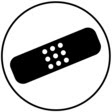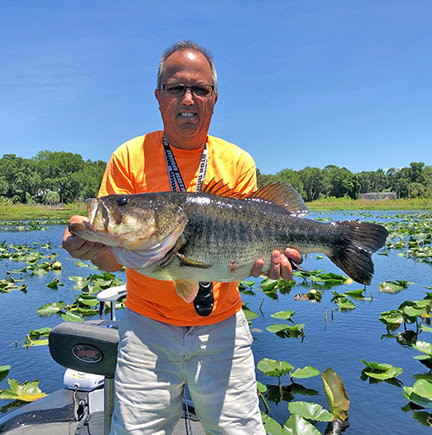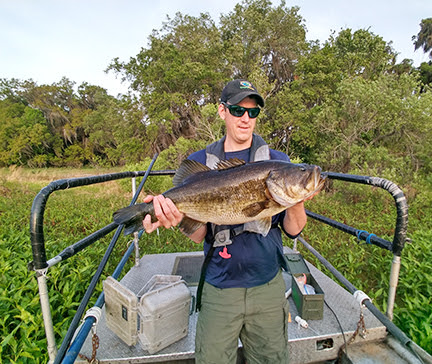Issue 41 | July - September 2025 |
 Our Purpose: To identify excellent Florida freshwater fishing opportunities and to provide anglers with relevant information that will enhance the quality of their outdoor experience. If you reached this newsletter through a website link instead of receiving it by email, you can subscribe free at the Subscription Topics page under "Freshwater Fishing". Having trouble viewing this email? View it as a Web page. |
TrophyCatch Tracker
Eric Bourne got his new personal best during an Xtreme Bass Series tournament on Johns Lake. We are now entering the final quarter of Season 13. TrophyCatch data attests that there are still plenty of trophies to be caught even during the warm summer months, so keep the sunblock and sports drinks handy and keep fishing! Good luck and tight lines as the season end nears, and if you have any unsubmitted catches, make sure you get them in. Each submission adds an extra 10 chances to win a Phoenix bass boat! The current season stats as of this quarter are below:
Register for TrophyCatch or view approved angler catches to help plan your next fishing trip at TrophyCatch.com. Follow TrophyCatch Facebook for featured big bass, program updates and partner highlights. For more news and freshwater information also follow us on the TrophyCatch Instagram.
The Division of Freshwater Fisheries Management Instagram page, @FishReelFlorida, changes its name to @TrophyCatchFlorida! The TrophyCatch Instagram focuses on all things bass fishing including your trophy catches, bass management, research, and partner news. Be sure to visit and follow the page for even more big bass news! If you were already following the original Instagram then you have been automatically migrated to the renamed page. Tag us in your big bass photos! Research Updates on Personal Best Bass CatchesDid you participate in the recent Personal Best (PB) Survey that TrophyCatch conducted? Here are some very interesting facts gleaned from that study. If you responded to the survey, we thank you! For everyone, we hope that this information will point to your next personal best! First, if your PB isn't the minimum 8 pounds required for TrophyCatch, don't be discouraged. You're in the right state and just need to keep casting! Reported PBs ranged from 1.1 lbs. (your first PB may have been about this size!) up to 16.6 lbs. The average PB weight was 9.6 lbs., and 77% of all PBs weighed 8 lbs. or heavier.
Reported Personal Bests (PB) ranged from 1.1 lbs. to 16.6 lbs. What's the best lure to throw at a trophy bass? Out of dozens of lure types, there was a single dominant winner: the plastic worm. Accounting for nearly half of all PBs at a whopping 48%, the venerable plastic worm remains the top bass lure. At the other end of the scale, if you're just getting started fishing there's no better lure to draw the attention of a passing bass. Following at a tie for distant second were topwater lures and other soft plastics at 13% each.
The plastic worm is hands-down the top lure to try for a new personal best. When's the best month to chase a new personal best? Survey respondents reported the most PB catches from March and April. This differed a little from TrophyCatch which has most approved submissions from February and March. What is certain is that bass are heavier and more catchable during the spawn, and any of these three months is an ideal time to go bass fishing. Also note that PBs were reported for every month of the year. While the spawn is important, big bass live in Florida year-round and Florida anglers are never out of the game!
Most PBs were caught in March and April, although TrophyCatch submissions peak for February and March. All three months are an excellent time to try for a trophy! We hope you found these facts as interesting as our biologists did. Follow TrophyCatch Facebook for more PB facts coming soon! Featured Fish: Bowfin
 The bowfin can be differentiated from the goldline (bullseye) snakehead by the much shorter anal fin on the underside of the body. Angling qualities: Most bowfin are landed by anglers trying to catch something else! Bass anglers are often surprised to find a bowfin has taken their lure — but may be equally surprised to discover that the lowly "mudfish" can put up a good fight. But don’t lip this fish when landing it! Remember that its mouth is loaded with sharp teeth. Bowfin will strike topwater and minnow-imitating lures but are most often caught on live bait such as shiners. Food quality is considered poor; the flesh is quite soft, but can be prepared smoked, fried as patties or stewed. In Louisiana the fish has been harvested commercially for caviar. Where to catch them: Bowfin are common in freshwater marshes or backwaters of lowland streams throughout Florida, as well as south Florida's canal systems. They can survive well in warm, poorly oxygenated waters; the bowfin has an airbladder that functions like a lung and the fish can sometimes be seen gulping air. Interesting facts: Males clear a nest among heavy vegetation. Eggs are laid at night and males guard them. Larvae use an adhesive organ to anchor themselves to plants or the bottom. Fish images by Duane Raver, Jr. and Diane Rome Peebles Braided Line Basics Part 2
Modern braids combine a light-tackle feel with brush-busting authority. In Issue 40 we highlighted modern braided lines. Incredibly thin and strong compared to monofilament, braids like PowerPro and other brands are a fishing game-changer! We continue our look in this issue. Despite its limpness, an advantage of braid in most situations is the fact that it has almost no stretch. Monofilament is quite stretchy, evident to any angler who’s ever had to break a mono line off a submerged stump. Braid, on the other hand, is tight as a wire — great for strike detection and solid hook-sets. With no stretch, however, braid can be less forgiving when fighting a big fish compared to monofilament, though the extra strength of braid helps offset that potential disadvantage. If you are new to braid, know that none of your old monofilament line knots will work. Make sure you check that little folded paper that falls out of the box when you open your new line to see which knots the manufacturer recommends for its brand — they can vary. Fortunately, one of the easiest knots, the Palomar, works pretty universally among the various brands of braid. It does waste a bit more line compared to the improved clinch knot, though you will probably not need to re-tie nearly as often when using abrasion-resistant braids than you do with mono. Note that as soon as your knot or line shows fraying, it’s time for a re-tie.
The Palomar knot is easy to tie and works with nearly all braided lines. Spin fisherman in particular will appreciate the benefits of thin but strong braided lines. For baitcasting gear, some of the features of braided lines such as limpness and small diameter make less of a difference, despite the fact that many of the earlier superbraids were designed (and advertised) with baitcasting in mind. However, most of what’s written here will apply equally to both gear types, and most modern braids work well with both spinning and baitcasting rigs.
One of the few disadvantages of braid is that it is not transparent like monofilament, although most anglers don’t notice a drop in strikes when switching between the two. Those that want to offset this disadvantage of braid usually add a monofilament or fluorocarbon leader. The leader is usually at least two to three feet, longer for ultra-clear water or especially wary fish. Mono is cheaper and works, but fluorocarbon is another modern wonder material that’s practically invisible underwater and has outstanding abrasion resistance. The chief disadvantage of fluorocarbon is cost — more than that of most premium braids — but not as hard on the wallet if you’re only buying a small spool for leader material. So that’s the skinny on braid. Monofilament will probably still have a place on your rod rack, but for heavyweight fishing on gear that still casts and feels light in your hands, braid can’t be beat! Featured Site: Little Orange Lake
Location: Hawthorne, Alachua County Size: 576 acres Description: Little Orange Lake (northeast of the larger Orange Lake) is located in Hawthorne, which is 17 miles southeast of Gainesville. This small lake is part of the Ocklawaha River drainage basin. To access the lake, you will have to launch at Holden Pond boat ramp then cross Holden Pond into a small, shallow canal on the northeast side that opens into Little Orange Lake on its southern shoreline. Dense mats of smart weed dominate the shorelines around the lake with spatterdock (water lilies) clumped together in areas that are around 5 to 6 feet in depth. The lake has a maximum depth of 15 feet. While you won’t be able to access the shoreline in the majority of the lake due to dense mats of smartweed, the water is typically 4-6 feet deep under the smartweed.
Some sport fish species you may typically find in this lake are Florida bass, black crappie (specks), bluegill, and redear sunfish (shellcrackers). Most of the fishing will be targeting fish along the aquatic vegetation either by smartweed or spatterdock since there is very little offshore structure at which to target fish. The docks on the southeast portion of the lake hold bass and crappie as well, which can provide some different options of areas to try and target fish. During this time of year when the water is very warm you can find bass underneath the edges of the spatterdock or dense mats of smartweed where it extends out to the cooler deeper water. Anglers should try fishing with artificials such as spinnerbaits, lipless crankbaits, soft plastics, and topwater lures along the edges where smartweed meets the spatterdock. You can also try live lining shiners underneath the smartweed for bass or small minnows out in the deeper water by the spatterdock for crappie. This past spring, FWC biologists conducted electrofishing surveys on Little Orange Lake for bass, finding the population in good health and good numbers. In addition to healthy populations of fish, the large amounts of undeveloped land surrounding the lake supports many other types of wildlife, allowing Little Orange Lake to support other popular recreational activities like alligator hunting and bird watching.
This hidden fishery has produced quality bass with 57 approved TrophyCatch entries. Of those 57 entries, 22 of them are double digit fish in the Trophy Club category (10+ pounds) with the biggest fish being 12 lbs. 6 oz. caught in 2020. The lake has the potential to grow bass into the Hall of Fame category (13+ pounds), due to its quality habitat and abundance of baitfish observed while doing electrofishing surveys for bass. Fisheries Biology: Common Fish Kill CausesThe sudden appearance of dead fish in a lake or canal causes considerable concern for most people. However, most fish kills result from natural causes. Too little oxygen in the water is the primary cause of fish kills in Florida. Cold weather also results in kills of nonnative tropical fish that have become established here. Although a fish kill in any particular water is usually a rare event, a number of fish kills do occur across Florida each year, and summer is the time that most of them happen. Low Dissolved Oxygen Fish Kills Fish, like people, need oxygen to survive. Most dissolved oxygen (DO) in the water is produced by aquatic plants through photosynthesis, using sunlight energy to produce oxygen. At the same time, however, oxygen is being removed from the water by the respiration (breathing) of fish, plants, and other underwater inhabitants. Decomposition of plant and animal matter in the water also consumes oxygen. Each water body usually undergoes a daily oxygen cycle. Under normal conditions, the DO in a water body is lowest in the morning just before the sun rises. As the sun comes up and aquatic plants begin to photosynthesize, the oxygen level rises steadily and continues to do so until the sun sets. Then the DO level drops continuously until the sun rises again.
The normal daily cycle of dissolved oxygen production. Production starts when the sun rises and stops when it sets. During cloudy weather with less available sunlight for photosynthesis, the DO may not return to the previous day’s high level. The next morning starts with a lower-than-normal oxygen level. If more cloudy days occur, the amount of oxygen can drop even lower.
Several continuous days of cloudy weather can repeatedly drop the oxygen level lower and lower. Several other factors can contribute to low DO. The rains associated with south Florida’s summer weather can wash large amounts of organic material (such as grass clippings and lawn fertilizer) into the water. Their decomposition will use up even more oxygen. In addition, warm summer water cannot hold as much dissolved oxygen as cooler water can. The combined result can be a fish kill, and this is more likely to occur during Florida’s cloudy and rainy summer weather.
Many of Florida’s fish kills occur during the summer rainy season. (Data from South Florida Water Management District.) Cold Weather Fish Kills Native freshwater Florida fish are rarely killed by cold. However, more than 30 freshwater nonnative fishes (fishes from other countries) are reproducing in Florida. Most of these species come from warm tropical climates and are less adapted to live here. During cold weather, water temperature may drop low enough to cause a fish kill. These kills are characterized by dead fish of only one to a few kinds of nonnative species. These kills occur during Florida’s cooler months. Cold weather fish kills and low oxygen fish kills account for the majority of fish kills that occur in the state throughout the year.
Different nonnative fishes have different lower lethal temperatures. (Fish illustrations by Diane Peebles and Duane Raver, Jr.) Preventing Fish Kills An aeration system can help prevent low oxygen fish kills. However, due to cost most lake owners (whether individuals or homeowner associations) may wish to wait to see if a kill was a one-time event before investing in such a system. Unfortunately, not much can be done to prevent cold-weather-related fish kills except preventing the illegal release of nonnative fishes. Report fish kills If you witness a fish kill, you can report it at the FWC Fish Kill Hotline (1-800-636-0511). You can also obtain more information about fish kills at the FWC Fish Kill website. To contact The Florida Freshwater Angler, email John Cimbaro. Fish illustrations by Duane Raver, Jr. and Diane Rome Peebles. |

















No comments:
Post a Comment